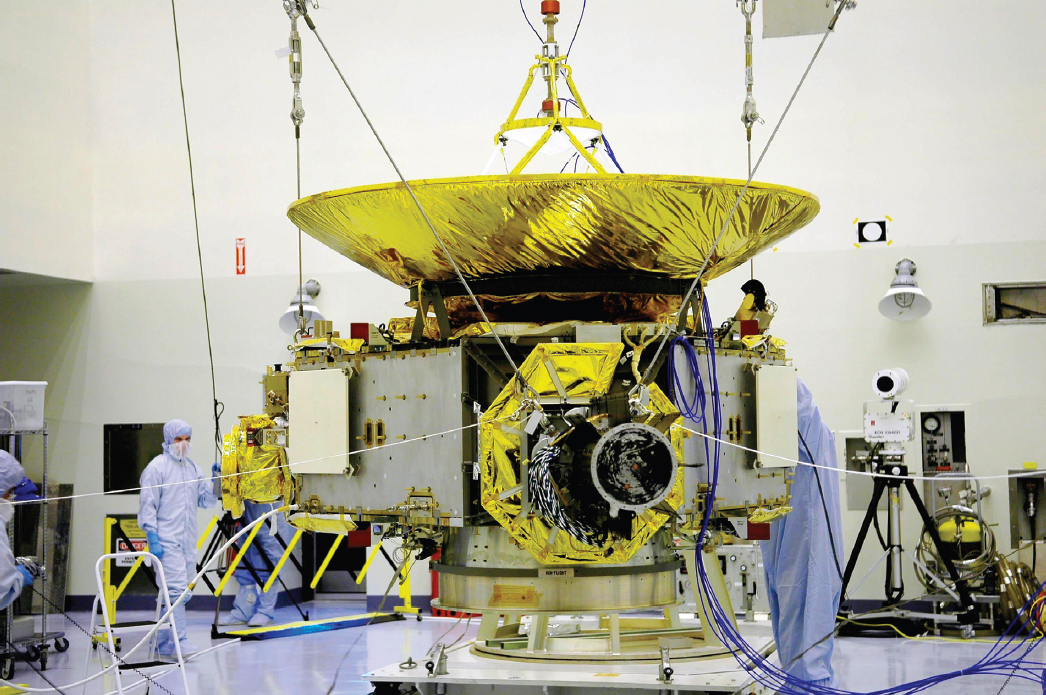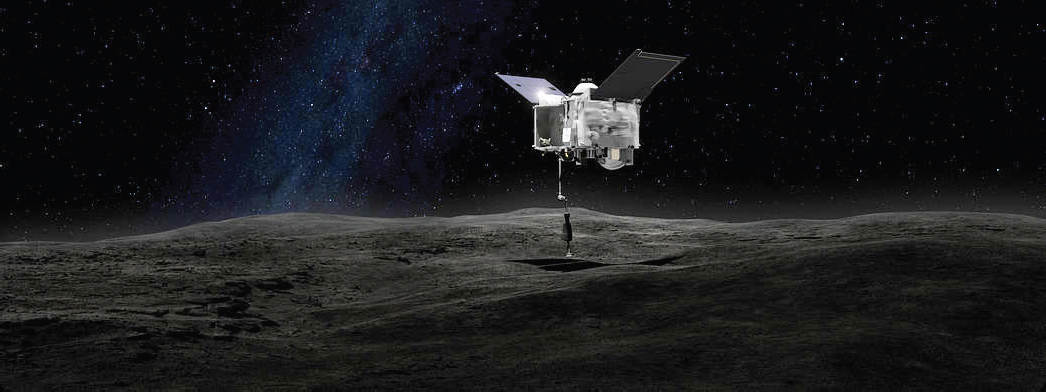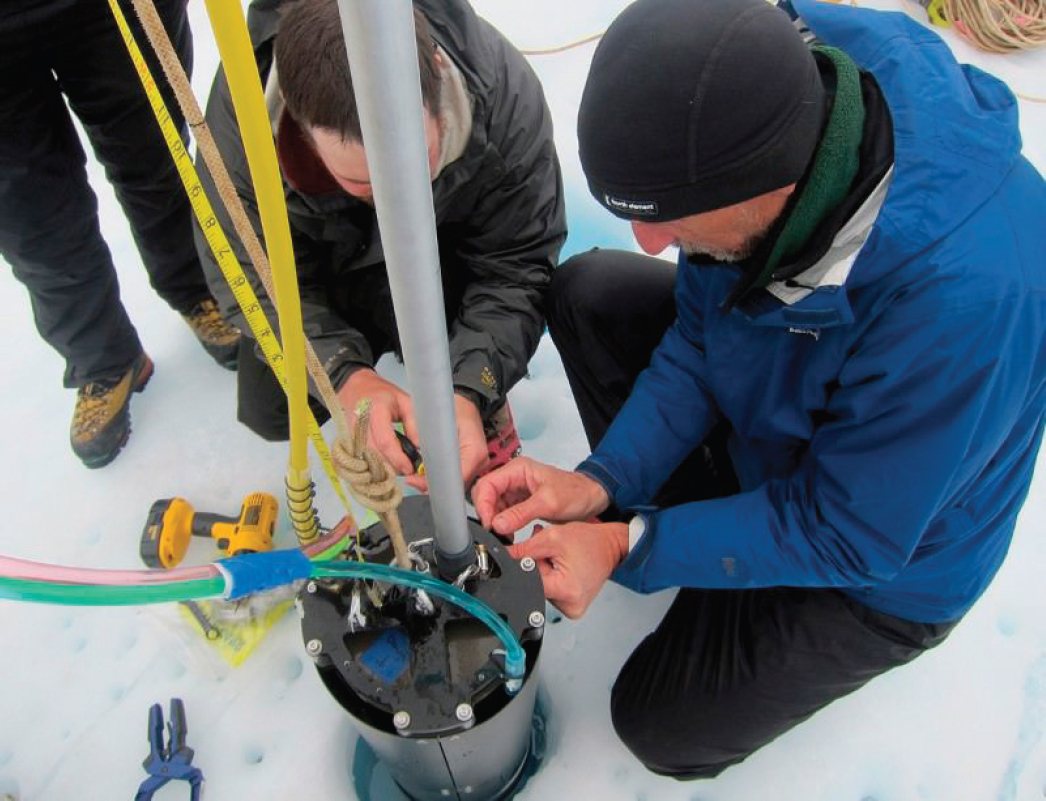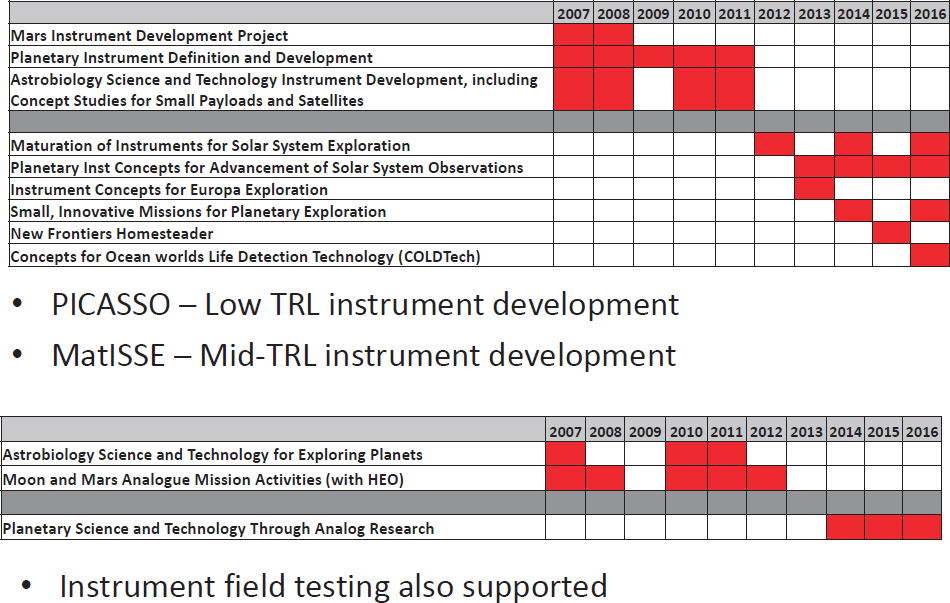4
Linkage Between Planetary R&A and NASA PSD Missions
The committee was charged with addressing two questions related to the Planetary Science Division’s (PSD’s) current Research and Analysis (R&A) program elements. The second of the two questions posed to the committee asks,
Are the PSD R&A program elements appropriately structured to develop the broad base of knowledge and broad range of activities needed both to enable new spaceflight missions and to interpret and maximize the scientific return from existing missions?
The committee elected to address separately the role of PSD R&A program elements in (1) interpreting and maximizing the scientific return from existing missions (see the section “Interpret and Maximize the Scientific Return from Existing Missions” later in this chapter) and (2) the enabling of new spaceflight missions (see the section “Enable New Spaceflight Missions” later in this chapter). Moreover, the committee interprets “existing missions” to include not only planetary missions that are currently operating, but also recent missions where primary data analysis is still being performed.
For their presentations to the committee, the chairs of the analysis/assessment groups and the NASA center leads for planetary science were asked, in particular, to provide their perspectives and those of their communities on how effectively the current program elements enable research based on current and past missions, as well as pave the way for future missions (Appendix C). In its discussion of this question, the committee’s assessment is that the present program elements perform well in enabling new missions and supporting existing missions, although there was a feeling that improvements could be made, particularly in preparation for future missions. Notable among these improvements, as delineated later in this chapter, are adequate support for development of instruments and facilities, and maintenance of scientific/technical expertise and analytical instrument capability for sample-return missions.1 Based on its deliberations, the committee concludes that the answer to the second question was a qualified “yes.”
___________________
1 The committee notes that while the present study was in progress, NASA’s Planetary Science Division commissioned the National Academies of Sciences, Engineering, and Medicine to undertake a review of the current status of sample-science facilities and the likely future needs of the U.S. sample-science community.
Finding: In general, the structure of the program elements will allow NASA PSD to prepare for future spaceflight missions and to maximize science value from existing missions. While there is room for improvement, no recommended mission concept identified in the planetary science decadal survey remains out of reach.
INTERPRET AND MAXIMIZE THE SCIENTIFIC RETURN FROM EXISTING MISSIONS
The availability of sufficient resources to support the analytical effort required to extract knowledge from raw mission data is a key component of planetary science research that extends beyond the activities of the mission science team. In addition, maximizing scientific return from existing missions entails more than just data analysis and involves a range of other activities within Planetary R&A, such as modeling and theoretical studies, cartographic work, laboratory-based analysis and experimentation, ground-based telescopic observations, and field-based (analog) studies.
Adequacy of Support for Data Analysis
As described in the section “Planetary Science Division R&A Program Elements” in Chapter 1, the R&A program elements include both core research programs and a collection of technology, instrumentation, data analysis, laboratory and field-based efforts. The committee’s approach was to examine the current structure of the R&A program (Figure 3.2) and determine whether there were data analysis programs (DAPs) that serve all existing missions.
As background, it should be noted that NASA policy requires that for each flight mission and investigation, some funding is allocated for the mission’s principal investigator (PI) and co-investigators to calibrate, validate, and publish the initial data set from the project. The funding for these efforts is not generally contained in the R&A program, but rather within the mission budget and contracts negotiated with the mission’s scientific team. To further maximize the scientific return from the set of ongoing missions, NASA long ago created so-called DAPs. The intent of these DAPs is to allow a broader group of science community researchers to collaborate with mission PIs and co-investigators using the mission data set to explore and interpret the planetary data produced. The committee’s examination revealed that, whether the mission is from the Discovery Program,2 New Frontiers Program3 (e.g., the New Horizons mission to the Pluto system, Figure 4.1), a strategic mission4 (e.g., the Cassini Saturn orbiter, see Figure 1.5) or a mission of opportunity,5 there is a corresponding data analysis program in Research Opportunities in Space and Earth Sciences (ROSES) that would allow a scientist to propose to conduct research using a current data stream. The ROSES NASA Research Announcement (NRA) also provides guidance for where to propose when a proposal addresses data from multiple missions or does not seem to have an obvious home in the current set of DAPs. Thus, the committee concludes that the current R&A program does, in fact, provide proposal opportunities that the community can utilize to maximize the data return from existing missions.
Finding: The current R&A program elements are appropriately structured to interpret and maximize the scientific return from existing space missions. In particular, there is sufficient scope and level of support in the current data analysis program elements to enable maximum return on the raw data from the present suite of missions.
___________________
2 Discovery missions are competed principal investigator (PI)-led missions that are not specifically identified by the planetary science decadal survey. For the most recent competition, total mission cost was capped at a Phase A-D cost of $450 million (fiscal year [FY] 2015), excluding standard launch services.
3 New Frontiers missions are competed PI-led missions selected from a set of candidate missions identified by the planetary science decadal survey. For the most recent competition, total mission cost is capped at $850 million (FY 2015) for Phases A through D, not including the cost of the Expendable Launch Vehicle (ELV) or any contributions.
4 PSD strategic missions, often referred to as flagship missions, are capability-driven missions that are directed to a NASA center and have total mission costs that exceed $1 billion.
5 Missions of opportunity allow the U.S. scientific community the chance to participate in non-NASA missions by providing funding for a science instrument or hardware components of an instrument. They also offer the possibility to use an existing NASA spacecraft for a new science investigation.

Adequacy of Support for Broader Range of Activities to Maximize Science Return from Existing Missions
The charge to the committee involves an evaluation as to whether the current R&A program is “appropriately structured to develop the . . . broad range of activities needed . . . to interpret and maximize the scientific return from existing missions.” The committee’s analysis paid particular attention to whether the scope of the current R&A program was sufficiently broad to encompass research derived from all mission data, past or present, and whether the scope of the current program elements allows that essentially any scientifically credible planetary research idea can be funded. To answer this question, the committee used the keyword analysis (see the section “Keyword Analysis” in Chapter 3) to assess whether the traditional range of planetary objects and disciplines was still addressed subsequent to the R&A reorganization. The committee did not concern itself with the absolute level of the funding, since that can vary with time and be a function of a given strategic imperative. As seen in Figures 3.4 and 3.5, which are derived from NASA PSD’s keyword analysis, all historically relevant target bodies and disciplines have continued to be supported both before and after the reorganization of the R&A program, with no indication of significant changes in funding levels above the statistical variance in the data.
Finding: The range of current R&A program elements is broad enough to address the full scope of credible research activities resulting from current and past missions.
ENABLE NEW SPACEFLIGHT MISSIONS
Adequacy of Support for Research that Enables Future Missions
As detailed in Chapter 2, the committee received presentations from NASA PSD staff on procedures involved in the PSD evaluation of R&A proposals since the reorganization. The committee also received commentary from the chairs of the analysis/assessment groups and from the NASA center planetary science leads on the types of proposals submitted and funded through the current programs and their communities’ perceptions of the current procedures. These proposals included a number that address the science issues that support future missions, including fundamental research to enable those missions. Such research activity includes the following: explaining current observations, testing hypotheses, refining the questions and explanations, and proposing tests to be addressed by future missions. The results of this research and analysis provide the basis for the most important goals and objectives for future missions and determine the desired measurements and the instruments to address them.
Overall, the committee heard no specific stakeholder concerns about insufficient scope in the current R&A program to fund appropriate mission-enabling research activities. Certainly, the committee assesses, there is no shortage of proposals for compelling science missions, firmly rooted in sound scientific research, for any of the planetary science mission announcements of opportunity (AOs). Nonetheless, NASA does not have the metrics to quantify the R&A impact on the development of future mission concepts, so it is difficult to assess whether highly innovative mission concepts fail to reach proposal stage for lack of precursory scientific research.
Finding: The scope of the current planetary R&A program appears to be sufficient to adequately support scientific research activities that enable future planetary science missions. Nonetheless, it was not possible to determine whether innovative mission concepts are adequately supported.
While there is sufficient scope in the current R&A program to support a broad range of mission-enabling activities, the committee is concerned that some essential research areas do not receive the appropriate priority in merit reviews. These research areas include general surveys of targets such as near-Earth objects (NEOs), transneptunian objects (TNOs), and Kuiper belt objects (KBOs); laboratory investigations; focused technical studies; research requiring substantial equipment investments; and cartography.
Finding: The committee has concerns that some activities that are critical components in addressing PSD science goals for future missions, which include long-term synoptic surveys (e.g., NEO, TNO, and KBO surveys), laboratory investigations, and planetary cartography, often receive a lower priority in science merit reviews.
Adequacy of Support for Technology Development that Enables Future Missions
Instrument technology development and instrument field-testing are part of the R&A program included in the annual ROSES solicitations. Such activities are critical for optimizing the science return from PSD missions, which often involve complex technologies (Figure 4.2). The most general and frequently utilized technology development programs6 are MatISSE (Maturation of Instruments for Solar System Exploration) and PICASSO (Planetary Instrument Concepts for Advancement of Solar System Observations), for both high and low technology readiness levels (TRLs), respectively. Program elements7 also exist for the development of instrument technology for future New Frontiers missions (Homesteader), future astrobiological instrumentation for Europa and other “ocean worlds8” missions (COLDTech—Concepts for Ocean worlds Life Detection Technology), missions to study the interiors of the gas giants and the surface of Venus and Mercury (HOTTech—Hot Operating Temperature Technology), planetary studies through emerging platforms such as CubeSats (SIMPLEx—Small, Innovative Missions
___________________
6 See also the section “Planetary Science Division R&A Program Elements” in Chapter 1.
7 See also the section “Planetary Science Division R&A Program Elements” in Chapter 1.
8 The ocean worlds are planetary bodies (other than Earth) that have liquid oceans either on the surface or in the interior. Obvious examples include Europa, Enceladus, and Titan, although recent spacecraft observations suggest that Ceres and Pluto may also qualify.

for Planetary Exploration; PSDS3—Planetary Science Deep Space SmallSat Studies), and research activities in environments on Earth that are analogous (Figure 4.3) to those on other planetary bodies (PSTAR—Planetary Science and Technology Through Analog Research). Other technology development opportunities exist for laboratory instrumentation through the Planetary Major Equipment (PME) and Laboratory Analyses of Returned Samples (LARS) program elements, which support efforts in the development of laboratory instrumentation and advanced techniques required for the analysis of returned samples and direct analysis of samples already returned to Earth. The evolution, and much of the current set of instrument technology programs, are shown in Figure 4.4. PSD has invested in new targeted technology development programs, when required by a compelling scientific case, based on new discoveries or by strategic priorities.
The objectives of these programs are aligned with the technology needs for future missions to address the science priorities in the 2011 planetary science decadal survey,9 and the breadth of programs provides a general structure that can support the development of technology and instrumentation needed to address NASA’s strategic goal for planetary science. However, the committee has concerns, based on its experiences and input from stakeholders, that the funding levels for these programs are not adequate to meet the needs of future missions. In particular, the committee is concerned about the level of funding for instrument development, sample-return technology development, research in environments on Earth that are analogous to those on other planetary bodies, and in situ resource utilization. The technical challenges of future missions, as outlined in the 2011 planetary science decadal survey, and the resources required to prepare technologies for flight and to maintain the needed scientific and technical expertise on mission timelines are considerable. The committee is concerned that while technology development is included in the R&A program it is not sufficiently prioritized by PSD.
Finding: In addition to scientific research, PSD’s planetary R&A supports the development of technology and instrumentation that enables future mission investigations. The variety of current technology and instrument programs is intended to address the breadth of technology development needs for the planetary sciences. However, future technically challenging missions recommended in the 2011 planetary science decadal survey justify enhanced priority for appropriate technology development.
___________________
9 National Research Council, Vision and Voyages for Planetary Science in the Decade 2013-2022, The National Academies Press, Washington, D.C., 2011.

In its deliberations about the LARS program, which supports laboratory instrumentation and advanced techniques required for the analysis of returned samples, the committee became concerned that the program is not being sufficiently funded to meet the requirements of future missions that are clearly anticipated by NASA PSD in its Mars (especially Mars sample return) and New Frontiers programs (particularly in the ocean worlds area). Although the first mission in a Mars sample-return architecture is approaching its critical design review, and the New Frontiers program was recently expanded to allow for missions to Enceladus and Titan (which may or may not include some form of sample return), the LARS program text in ROSES 2016 mentions both New Frontiers and Mars sample return as missions that “are expected to have low priority for LARS funding.”10 That “low priority,”
___________________
10 NASA Science Mission Directorate, NASA Research Announcement: Research Opportunities in Space and Earth Sciences 2016, Solicitation: NNH16ZDA001, https://nspires.nasaprs.com/external/solicitations/summary.do?method=init&solId=%7B68C12087-132D-3814-9A875323BCE6CAB6%7D&path=open, accessed April 12, 2017.

especially for development of techniques required for the analysis and handling of returned samples, including cryogenic ones, could result in NASA being unable to develop required capabilities and community expertise to effectively and safely implement these compelling sample-return missions. Working with such returned samples will necessitate advanced technical and analytical capability to make the required measurements. Furthermore, it is important to retain the capacity to design and implement the investigations on samples both in space and on Earth. Given planetary protection requirements and the needs for receiving laboratories and curation facilities (with appropriate instrumentation) that protect the samples from Earth contamination while also protecting Earth from potential extraterrestrial organisms, the committee notes that the timelines for this development are already challenging.
Finding: NASA has not demonstrated that its PSD R&A program can enable future spacecraft missions that will return samples of biological interest from Mars or cryogenic samples from icy bodies and receive, curate, and analyze them on Earth.
Recommendation: NASA should support the development of the technologies required to return astrobiological and cryogenic samples to Earth and the appropriate containment, curation, and characterization facilities consistent with the Planetary Science Division’s science goals and planetary protection requirements.
Adequacy of Support for High-Risk/High-Payoff Research that Enables Future Missions
NASA encourages high-risk/high-payoff technology development through programs such as Concepts for Ocean Worlds Life Detection Technology (COLDTech), Hot Operating Temperature Technology (HOTTech), and Small Innovative Missions for Planetary Exploration (SIMPLEx), and with the MatISSE and PICASSO programs that address TRL advancement in order to move beyond the “valley of death.”11 However, while the current R&A structure does not prevent high-risk/high-payoff technology development proposals from being funded, in reality such proposals are at a disadvantage due to risk aversion in the review and selection process. The committee deliberated on this topic at considerable length and, based on its own experience, concluded that this risk aversion has a similar motivation to that discussed for high-risk/high-payoff science (see the section “High-Risk/High-Payoff Research Activities and Advanced Technology” in Chapter 3).
Finding: R&A technology investments needed for future missions, as identified in the 2011 planetary science decadal survey, require innovative approaches that may be high-risk/high-payoff and are less likely to be supported under the existing program.
Adequacy of Long-Term Support of Scientific and Technical Expertise and Instrumental Capabilities
Because of the intrinsic relationship between PSD’s R&A program and the successful definition and operation of planetary missions, the program comprises more than a pure science examination of a list of questions about the universe, or the development of clever and capable technology for those missions. It is essential for PSD’s R&A program to have as one of its goals the sustainment of support for special-purpose instruments and other facilities on Earth that can enhance multimission investigations and continuing post-mission science and engage the appropriate technical and scientific expertise to operate them. These capabilities are essential, but often their preservation is not formally acknowledged in the development of R&A program elements, research announcements, or mission AOs.
The committee acknowledges that this is not an easy problem to solve. Various approaches have been attempted over the years that balance the maintenance of current capabilities against the development of new approaches and methods and the ebb and flow of mission opportunities. Each approach known to the committee has had its shortcomings—largely because different timelines are associated with R&A grants and new mission development and flight (particularly to the outer solar system). The challenges of planning for an emerging emphasis on sample-return missions—especially sample-return missions from bodies like Mars, Europa, and Enceladus that may support their own life forms—add further complications to achieving balance between near- and long-term needs. Such sample-return missions will have even longer timelines, and more comprehensive post-mission demands, than have been seen by NASA since the return of lunar samples in the late 1960s and early 1970s. Nonetheless, NASA has a need (and in the case of sample-return missions, a critical responsibility) to rise to those challenges.
Finding: The reliance of principal investigators on R&A awards (normally offered every 3 years) alone to sustain the critical scientific and technical expertise and infrastructure needed for current and future planned missions can be a challenge. This issue is a particular concern for sample-return missions where laboratory analytical techniques and expertise may need to be sustained so that they remain available when samples are finally returned.
Recommendation: In making funding decisions for the various research and analysis program elements, NASA should consider the need to sustain critical scientific and technical expertise and the instrumental and facility capabilities required for scientific return on future missions, as discussed in the 2011 planetary science decadal survey.
___________________
11 The technology development “valley of death” is the dip in the curve of available funding versus technology maturity, where the incremental cost to advance the technology increases and funding availability drops. This frequently occurs as technology evolves from prototype to pilot stages. The MatISSE program element was specifically designed to bridge this gap.








